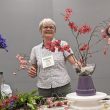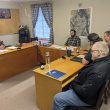It was getting close to lunch time and, well, that was becoming a little obvious as Angela Clegg discussed the life cycle of salmon with a group of sixth-graders from Seven Oak Middle School in late September at Northside Park in Sweet Home.
The interaction was lively, but attention was beginning to wander just a bit.
Clegg, coordinator with the South Santiam Youth Watershed Council, was leading a learning station of the annual Salmon Watch Field Trip on a warm Thursday morning with science teacher Amanda Sater’s students.
The topic at this moment was instinct and the fact that salmon kind of know what to do on their own during their years-long trip to the ocean and back to the South Santiam River, where they were born. They don’t need help, such as Siri, the intelligent personal assistant that part of Apple smart phones, as one student suggested.
“They go by instinct,” Clegg said, doing some quick mental footwork as she interacted with the students. “They don’t have Siri. Their instinct is their internal Siri.”
One student suggested that salmon’s lives must be “boring.”
“Boring?” Clegg responded. “I don’t know. It’s pretty exciting. They have a whole bunch of stuff down there. Their whole life is about surviving.”
Sater’s students were among some 450 from Lebanon and Sweet Home that participated in Salmon Watch this year, learning about salmon and their habitat. This was one of 10 field trips, over the course of three weeks, in which youngsters spent the day at the park on the shore of the South Santiam River.
During the annual Salmon Watch field trips, the students visit four stations covering four subject ares: fish biology, water quality, macro invertebrates and riparian ecology.
Each station is staffed by volunteers, who include local high school students from the Youth Watershed Council.
The Salmon Watch field trips are educational, Clegg said. “We do this at this time of year because the salmon are running.”
They hope to catch sight of salmon in the river, she said, but they hadn’t seen any as of the end of September.
During the field trip, the students learn about salmon and how important they are as a keystone species, Clegg said. A keystone species is one on which other species in an ecosystem largely depend and, according to scientists, if it were removed the ecosystem would change drastically.
The four stations are designed to explain how salmon survive and live.
At the macro invertebrates station, students collected insects, which can be divided into three categories based on their tolerance to pollution, including tolerant, neutral and intolerant.
The insects can show how healthy the insects are for the fish and how good the water quality is based on what insects they find, Clegg said. In a classroom they can compare what they find with locations around the region.
Ideally, among species, they’ll find mayflies, stoneflies, caddisflies and dragonflies, she said.
Students busily dipped water from the river with beakers, which they scrutinized with magnification lenses.
“Tapping seems to terrify them,” observed Carson Anliker, looming into a beaker full of small critters.
At the riparian ecology station, “they’ll look at canopy shade,” she said. They’ll use a densiometer to measure canopy cover.
“They’ll look at the geology, the rocks, the substrate,” Clegg said, and they talk about what trees and shrubs are important and how the riparian area functions as a filter for runoff from rainstorms.
At the fish biology station, they learn about the fish itself, why it goes to the ocean and how it is able to move from fresh to salt water, she said. Under the guidance of a fish biologist, they also examine fish specimens.
At the water quality station, they take samples of water looking for dissolved oxygen, turbidity, air temperature, water temperature and pH levels, she said.
Volunteer Karl Hartzell of Corvallis led the water quality station. He’s been involved in the program since 2007, he said.
“I like the interaction with the kids. Sometimes they can be somewhat unruly, but that’s relatively rare. If you can keep them on track, keep them engaged, interactive, then things work pretty well.
“Of course, they love being out here, close to the water. The tendency is that they want to play in the water, especially when it’s warm. but you just keep them on task and things work out.”
During a break for lunch, student Hayden Metzker said he’d learned that a salmon’s heart “looks like a triangle.”
“It’s like a pyramid, triangle thing,” Landon McKenery chimed in, prompting a spate of commentary from several others seated around a picnic table.
Landon said the trip turned out to be more interesting than he’d expected.
“At first I thought it was going to be really boring until I found out they were going to cut open a fish,” he said. “And then we got to touch its organs.”
Sater, their teacher, said she likes the trip because students get to see in real life what they’ve been learning about in the classroom.
“We study salmon in the classroom and it’s fun to see it out here,” she said. “We have some kids who’ve gone fishing, but it’s different than learning about every stage and where they live.
“I think it’s good to get them outside, have a classroom outside so learning is not just within four walls.”
– Staff Writer Sean C. Morgan contributed to this article.










